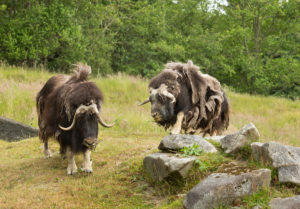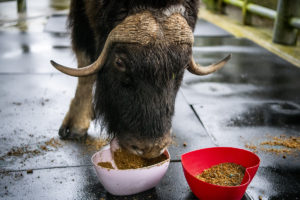Calf expected this summer

Point Defiance Zoo & Aquarium has one more reason to celebrate muskoxen Charlotte and Hudson this Valentine’s Day: they are expecting a calf this summer.
Recent tests confirmed five-year-old Charlotte is pregnant, zoo General Curator Dr. Karen Goodrowe said. The father is four-year-old Hudson.
Charlotte experienced pregnancy for the first time last August, but unfortunately the pregnancy resulted in a stillborn.
“We’re closely monitoring Charlotte to help ensure all goes smoothly for her with this pregnancy,” said Goodrowe.
Hudson came to Point Defiance Zoo & Aquarium in July 2016 as a young calf from the Large Animal Research Station at the University of Alaska, Fairbanks.
Charlotte followed a few months later from the Alaska Zoo. They were paired together in hopes they would eventually mate. The pair gets along well and can be seen in the Arctic Tundra habitat. Keepers also give them time apart to roam their habitat.
Positive pregnancy test
Charlotte didn’t pee on a pregnancy test or even have an ultrasound to confirm her pregnancy. Instead, animal care staff collected her fecal samples on a daily basis starting in August 2019 and sent them to another zoo laboratory to test for hormonal changes in her fecal samples, or poop, to verify the news.
Keepers mixed in blue glitter with Charlotte’s food to ensure they were collecting her feces and not poop from another muskox.
“Because there is not a good blood test to confirm pregnancy in muskoxen and we are unable to perform an ultrasound on Charlotte, collecting her poop and measuring hormones in those samples is a great way to non-invasively determine pregnancy and to determine a specific time-frame for when she conceived,” said Goodrowe.
The gestation period for muskoxen is eight and a half months.
A rare birth

Only three zoos in the United States currently have muskoxen: Minnesota Zoo, Alaska Zoo and Point Defiance Zoo & Aquarium.
“Our staff has become well-acquainted with Charlotte since she first arrived in 2016 and we are very excited to watch her become a mother,” said Shannon Smith, the assistant curator who oversees the team that cares for muskoxen at the zoo.
If all goes well, within a few hours of being born, the calf should be able to walk and keep up with Charlotte. Charlotte will nurse her calf for about a year. A calf typically weighs 22 to 31 pounds when it’s born and rapidly gains weight. By the time the calf is a year old, it will weigh 150 to 235 pounds. Adult muskoxen can weigh up to 800 pounds.
Muskox wool, known as qiviut, is stronger and warmer than sheep’s wool and the calf will find comfort and warmth huddling up to Charlotte in the fall and winter.
Saving a species
Muskoxen were hunted for meat and hides in the 19th and 20th centuries, and their populations plummeted. The Northwest Game Act of 1917 allowed for conservation efforts that helped their recovery, and there are now about 80,000 muskoxen in the wild.
They are native to Arctic prairies and tundra and are commonly found in Greenland, northern Canada and Alaska. These relics of the Ice Age are part of the Bovidae biological family, which includes bison, buffalo, antelope, gazelle, sheep, goats and domestic cattle.
Muskoxen have been part of Point Defiance Zoo & Aquarium’s animal family for nearly 40 years. In addition to Charlotte and Hudson, the zoo is home to 16-year-old Mya.